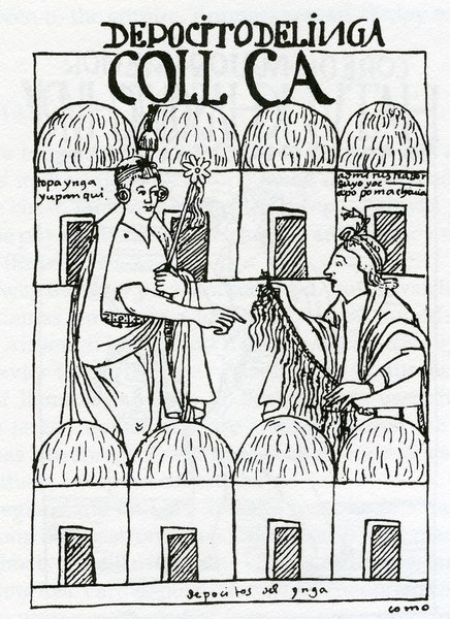As modern-day Americans are in the midst of preparing their taxes this season, take a look into our collections to learn about one of the oldest known forms of tax recordkeeping by Indigenous Americans.
Quipu — or ‘khipu’ in the Quechua language — is a centuries-old form of information-keeping from the Incan and Andean mountain peoples of South America. Starting from at least the 9th century, Incan and Andean peoples used quipus for numerical recordkeeping, including to keep track of farmstock, debts owed, and taxes owed or paid.

The quipus were typically constructed out of either cotton or animal fibers, dyed in a variety of colors, and turned into threaded cords. The cords were then knotted at intervals indicating, at least within the Incan quipus, decimal places used in numerical recordkeeping. The Quipucamayoc, or khipu kamayuq (the “khipu-authority”), who made and read these cords, can be seen in historical illustrations such as "Historia y genealogía de los reyes Incas del Perú del Padre Mercedario Fray Martín de Murúa," and images featured in this Dumbarton Oaks Library online exhibit.
There is still debate about quipus being entirely numerical in use, as many quipus remain untranslated and may have been used as a form of storytelling or holding historical records. The existing collections of quipus are also far from representative of all that once existed, as thousands of quipus were destroyed during Spanish colonization of Incan and Andean homelands in the mid 1500s. As such, we unfortunately might never fully know what stories the quipus held.
The remaining quipus, despite being 500 years old or more, continue to inspire artists today with their beautiful, woven storytelling. Works inspired by or incorporating quipus include a collection of poetry by Arthur Sze held at Tozzer Library and the sci-fi dystopian novel “This is How You Lose the Time War” by Amal El-Mohtar and Max Gladstone, which features quipus as a form of secret letter-writing.
The Quechua language, through which Incan history lives on, continues to be spoken by nearly 10 million people globally. Quechua is alive at Harvard at the Quechua Initiative on Global Indigeneity, headed by Dr. Américo Mendoza-Mori, who also founded The Quechua Alliance as an organization promoting Andean culture in the United States. Hundreds of books on the Quechua language and Incan history can be found in our Special Collections, such as a facsimile of the “El primer nueva crónica y buen gobierno” by Quechuan author and illustrator Felipe Guamán Poma de Ayala, who advocated in the late 1500s for the Indigenous populations of the Andes and highlighted their brutal treatment by the Spanish government. More materials on quipus and the Quechua language can be found at Tozzer Library, Dumbarton Oaks Library, and many other libraries across campus.
Julie Fiveash is Harvard's first Librarian for American Indigenous Studies. Based at Tozzer Library, they focus on organizing, spotlighting, and acquiring Indigenous materials. Much of their work is centered around helping researchers find and navigate Indigenous collections, including the ones mentioned in this piece that showcase centuries-old recordkeeping of South American peoples.